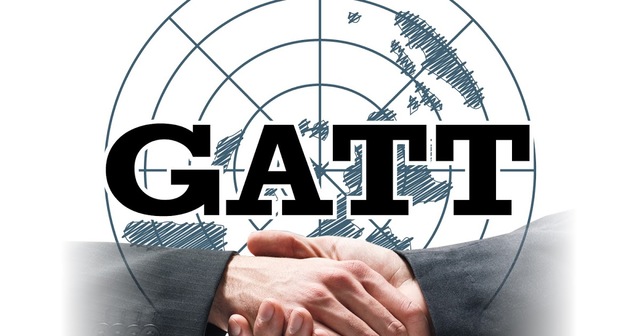This article has been written by Mridul Tripathi who is currently pursuing BBA LLB from Vivekananda Institute of Professional Studies. This is an exhaustive article on the social, economic, political and the cultural conditions that persisted before the formation of the General Agreement of Tariffs and Trade (GATT).
Table of Contents
Introduction
The Beggar-thy-neighbor policies that were widely adopted by major nations during the great depression of the 1930s followed by World War two led to the need for a system of regulation which would support post-war reconstruction, economic stability and peace. The General Agreement on Tariffs and Trade was a multilateral contract to liberalize trade restriction.
The General Agreement on Tariffs and Trade (GATT) was signed by 23 countries at its conception and this first agreement articulated basic rules of a world trading system, which would be refined periodically in a series of multiyear “rounds” of negotiations. Fifty years later, on the 1st of January 1995, The General Agreement on Tariffs and Trade became the World Trade Organization with 123 member countries.
In this article, the author has attempted to look at how this international policy that put into place an economic system, has gone on to not only formulate and overlook but also dictate certain principles and values on which the nations of the world have functioned. Its inception came during a period when the world was confronted with choices between systems and policies, when new nations were coming into being and when an era of colonization was ending and imperialism – where it stands now in its current form was setting foot.
Conditions before the First and Second War
Before World War I, the world economy enjoyed several decades of relative peace- in terms of both international trade and monetary relations. During 1860-1913, world trade relations pivoted around a network of bilateral trade treaties which contained the clause of most-favoured-nation (MFN). Each country was free to set and change its tariff rates as long as they adhered to the MFN clause. These arrangements arose without multilateral cooperation.
This regime, despite the lack of oversight mechanism or institutional basis, brought about relatively low trade barriers-almost exclusively tariffs and very little trade discrimination. International trade flourished during this period.
This scenario stood in place until the start of World War I in 1914. World War I shattered the treaty network as countries started imposing higher tariffs, import quotas, licensing requirements, and foreign-exchange controls. The period after the War lacked any institutional mechanism to facilitate the reduction of the trade barriers that had arisen between the countries during the war. This hampered economic reconstruction greatly.
Further, as the depression set in, it ended any serious prospect of trade reform in Europe and other nations as well, and the 1930s were a disaster in the field of commercial policy. The countries became even more protective and they implemented discriminatory trade and currency blocs which created innumerable impediments to international commerce and hampered economic recovery.
It was certain to some nations that the “non-system” that was prevalent in the 19th century would not set in again after World War II. Therefore, the United States and the United Kingdom kick-started building ground during the early 1940s for an international agreement to revise and implement new commercial policies that would have helped in reducing trade barriers and limiting discriminatory tariff preferences.
The political and social conditions
In October 1947, the General Agreement was signed by 23 nations that had pledged implementation of the tariff reductions and an extension of “most-favoured-nation” treatment to all participants. It was made mandatory for the founders, as formal members, to pay dues and notify the organizations of changes in trade policy. Along with having participation rights in multilateral trade negotiations and annual meetings, they also enjoyed voting rights.
Other countries also enjoyed the same privileges and benefits as the founders, if they acceded to the agreement. Most of the founding members, even the United States, retained colonies and their overseas territories. The General Agreement included a specification that suggested that if the colonies were sponsored by their parent state, they could avail the benefits of membership.
As most parts of the world were experiencing colonial rule in the late 1940s, this clause aided in expanding the scope of the agreement beyond the original signatories. As most of the countries expanded the benefits to their colonies, the major chunk of the participants was the colonies.
The driving force behind the General Agreement on Tariffs and Trade was the same as that which motivated the Bretton Wood conference in 1944: the interwar disaster. The interwar period was not just a series of domestic failures but also a failure on the international level.
Hence, the three fundamental principles inscribed in the General Agreement on Tariffs and Trade were all based on non-discrimination. The consistent thrust of the General Agreement on Tariffs and Trade was to remove barriers to trade through the application of three fundamental principles: Most Favoured Nation (MFN) status, National Treatment (NT), and market access.
The MFN principle prohibits countries from offering preferential trade privileges to one nation and not to others. Therefore, the United States could not have reduced import duties for Chinese goods without offering the same advantage to all other countries.
An application of the National Treatment principle meant that countries would not have granted advantages to their national industries that were not also available to foreign industries. If subsidies were to be provided to the US car manufacturers then that should have also been provided to the foreign entities.
Yoram Z. Haftel in his review of the meticulous work ‘Power and the Governance of International Trade: From the General Agreement on Tariffs and Trade to the WTO’ by Soo Yeon Kim, which came out in 2010 makes an interesting point. He asks, “what prevents members of the WTO from striking a deal that—according to some forecasts—could boost economic growth and prosperity the world over?” He said that an answer to this question requires an understanding of the forces that shaped the WTO and its predecessor, the General Agreement on Tariffs and Trade, and how the architecture of these institutions reflects the interests of their creators (or not).
He also focuses on the point that like any other social institution, the multilateral trading system benefits some members more than the others and the same has been noticed when it comes to GATT.
In the first part of the book, Soo Yeon Kim argues that the rules of the multilateral trade institutions were designed by its more powerful members, the first and foremost being the United States. The second part of the book shows that the General Agreement on Tariffs and Trade and the WTO benefited the United States and a few of its allies at the expense of other member-states, especially the developing countries.
Thus, the multilateral trading system neither promotes commerce or trade impartially nor is it a product of globally accepted norms. Rather, this system was shaped in Washington to advance, above all, American economic and political interests.
In this regard when we read the reports on the experience of developing countries — the benefits or the lack thereof received by the developing countries of whom such as India, a newly independent nation. On one hand, it could be said that from the Havana conference to now, developing countries, again and again, have been frustrated in getting the General Agreement on Tariffs and Trade to reflect their concerns. Tariffs and other barriers in industrialized countries on their exports were reduced to a smaller extent than those on exports of industrialized countries in each round of the Multilateral Trade Negotiations.
Products in which they had a comparative advantage, such as textiles and apparel, were taken out of the General Agreement on Tariffs and Trade discipline altogether. Agriculture, a sector of great interest to developing countries, largely remained outside the General Agreement on Tariffs and Trade framework. In sum, one interpretation is that the GATT was indifferent, if not actively hostile, to the interests of developing countries.
Some researches show that several developing countries tried, and failed, to advance rules that would provide only industrializing members with greater flexibility and recourse to protective measures. It appears, then, that power differentials were indeed an essential element of the General Agreement on Tariffs and Trade story, but the dividing line was not only between the American hegemony and the rest but also between the North and the South. Statistics have shown that the trade between these two groups has declined.
It is argued by Kim that the negotiations of the GATT took place “in the shadow of the preponderance of American power” and that this reality was highly consequential for its specific rules and procedures. To demonstrate this claim, she begins by highlighting three US goals in connection with the negotiations:
- improving the access of American firms to global markets;
- assistance and support to its European allies;
- shielding domestic sectors that may have to shoulder the costs of the Agreement, that is, exceptions to tariff negotiating items following sometimes directly from the US law.
These preferences are then linked to key features of the GATT. The insistence on non-discrimination (enshrined in the principle of the most favoured nation) and the centralization of bilateral negotiations under one multilateral banner were instrumental in the simultaneous dismantling of all members’ trade barriers. Thirdly, American insistence on a product-by-product bargaining method (rather than across-the-board tariff cuts) allowed its negotiators to protect specific interests.
Another significant political detail that research has brought forward and is reflective of this power play is, in 1955 the US obtained a permanent waiver for its system of agricultural price support under the terms of the Agricultural Adjustment Act, 1933, a move contested by Canada, Denmark, the Netherlands, and New Zealand among many others. This affected the further policy-making regarding agriculture and these market destabilizing policies left the world agricultural prices distorted and artificially low.
Finally, it is worth emphasizing that though the political scenario has changed in different countries, (for the better or for the worse is up to our analyses) the social and the cultural have been deeply impacted by the GATT and the WTO. These articles of the policies made have had more deep-rooted impacts in the politics of today than the layman can discern. It figures that the politics around the formation of the GATT was only a glimpse into the economic system of the world that was going to be sketched upon the principle of liberalism, which was embedded by the General Agreement on Tariffs and Trade.
Cultural reasons
Culture may be a notoriously difficult concept to define, but many countries view national cultural production as expressions of national identity. Some countries, especially countries with rich film traditions, which would encompass all the major European countries, did not want to see their film industries interred under the weight of U.S. imports. In this respect, we come across an interesting detail of how the General Agreement on Tariffs and Trade was to affect the global culture that was to come into being and how was a culture or cultural exchange was being perceived in the times post the wars.
While the General Agreement on Tariffs and Trade generally did not contain quotas, this article permitted minimum screen quotas for “cinematograph films.” France was one of the countries that insisted on the inclusion of Article IV, an early indication of the importance France attached to the cinema though this provision was written into General Agreement on Tariffs and Trade at a time when the European film industries were still recovering from the war, all subsequent rounds left this clause intact, and it remains in force.
Using data from the interwar General Agreement on Tariffs and Trade had a large positive effect on five of its member states: Britain, United States, Canada, France and Germany.
Conclusion
The General Agreement on Tariffs and Trade or later that resulted in the formation of WTO is a successful international institution. Membership in the General Agreement on Tariffs and Trade/WTO has expanded since its founding, and international trade has grown ever since its establishment. It is common for the observers to assume these trends are linked but only a few have attempted to quantify the General Agreement on Tariffs and Trade/WTO’s effect on the level and direction of trade.
In fact, contrary to expectations, the leading statistical analysis to date finds little to no evidence that the General Agreement on Tariffs and Trade/WTO increased trade amongst all members, after controlling many major factors such as national income, geography and other factors that affect the flow of goods between nations. From the inspection that this paper indulged in, we see how the politics of those times has affected the social. We saw how the nations sought security in concretizing their space in the ‘global exchange of culture’ narrative. Thus, we see that the “compulsory power” of the United States at the end of World War II allowed it to design the General Agreement on Tariffs and Trade rules that tilted the global trade system in its favour. Furthermore, we arrived at an understanding that the initial rules transformed compulsory power into institutional power, which has a high degree of resilience, thus cementing distributional inequalities.
References
-
Soo Yeon Kim, The Power and the Governance of Global Trade: From the GATT to the WTO (Cornell University Press, 1st Edition, 2010)
- Irwin, Douglas A. “The GATT in Historical Perspective.” The American Economic Review, vol. 85, no. 2, 1995, pp. 323–328. JSTOR, www.jstor.org/stable/2117941
- Goldstein, Judith L., et al. “Institutions in International Relations: Understanding the Effects of the GATT and the WTO on World Trade.” International Organization, vol. 61, no. 1, 2007, pp. 37–67. JSTOR, www.jstor.org/stable/4498137
- Finlayson, Jock A., and Mark W. Zacher. “The GATT and the Regulation of Trade Barriers: Regime Dynamics and Functions.” International Organization, vol. 35, no. 4, 1981, pp. 561–602. JSTOR, www.jstor.org/stable/2706411
LawSikho has created a telegram group for exchanging legal knowledge, referrals and various opportunities. You can click on this link and join:












